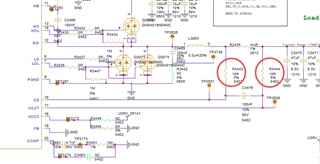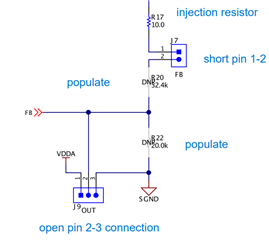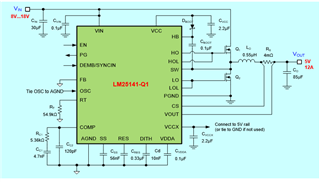Other Parts Discussed in Thread: LM25141, LM5141-Q1,
Tool/software:
How to measure the Bode of LM25141? Where to inject interference signals? R3443 or R3444?

This thread has been locked.
If you have a related question, please click the "Ask a related question" button in the top right corner. The newly created question will be automatically linked to this question.
Tool/software:
How to measure the Bode of LM25141? Where to inject interference signals? R3443 or R3444?

Hi Xianfeng
Please upload your full schematic as I can see partial image only. R3443, R3444 are part of current sensing part.
For measuring BODE, you need to add external feedback divider to measure the loop and test using conventional techniques. The values of feedback resistors do not matter, only the ratio of the feedback resistors matters, effectively the gain from Vout to FB. Please make sure that the Thevenin equivalent impedance of the resistive divider connected to the FB pin must be greater than 5 kΩ to detect the divider.
Otherwise, you can check the bode plot using the excel tool here . Please fill the excel tool and check the bode plot.
Hi Xianfeng,
Thanks for full schematic. As I have said, you need to install an external feedback divider and test the bode as per usual technique.
Thanks
Arpita
Hi, Arpita. According to the LM5141-Q1 EVM User's Guide, the FB pin is connected to ground to get a 5V output. If I need to test the bode, what should I do? Still need to add external feedback divider to FB to get 5V output instead of connecting to ground? Thanks
Hi Siv,
the default setting of J9 [FB connection] is FB is shirted to GND to get 5V output in the EVM.
As explained above to measure bode, kindly disconnected the short between J9-pin 2 to 3 and place the external dividers. Otherwise, you can find experimental the bode plot given in EVM user guide or you can get the bode using the excel tool itself.
R20 (RFb2), R22 (Rfb1) can be calculated using the following eq [4] from datasheet or you can use the excel tool attached previously.


Arpita, thanks for your advice.
1) Also, I am wondering if the ''disconnect the short between J9-pin 2 to 3 and place the external dividers" action has different loop response (shown in Bode) compared to FB shirted to GND to get 5V output. I recently learned about Type II transconductance compensation for peak current mode, and I think Kfb is also a part of transfer function. Is Kfb the same for both two ways?
2) For loop compensation, I mentioned that in the LM25141-Q1 quick-start calculator excel, there is no Cc2 for compensation. Only series Rc1 and Cc1 are connected to COMP pin. Under which circumstance can we not use Cc2 for compensation.
Really appreciate for response.
1) Also, I am wondering if the ''disconnect the short between J9-pin 2 to 3 and place the external dividers" action has different loop response (shown in Bode) compared to FB shirted to GND to get 5V output.
As I have already explained. the values of feedback resistors do not matter, only the ratio of the feedback resistors matters, effectively the gain from Vout to FB. For Vout=5V, either you use external or internal feedback, the ratio of feedback resistors and effectively the gain from Vout to FB remains same. You can have a look into the transfer function, only the "ratio" of the feedback resistors matter.
What do you refer to by Kfb?
2) I mentioned that in the LM25141-Q1 quick-start calculator excel, there is no Cc2 for compensation. Only series Rc1 and Cc1 are connected to COMP pin.
I could not see any discussion regarding this in the thread. Can you please elaborate what do you mean by this? There is CC2 in the excel file. For eample, please see the below image. Could you please share the filler fin calculator for better understanding?

However, for very high switching frequency ~2.2MHz, adding a HF pole by using CC2 can degrade the phase margin. That's why it is suggested not to add external CC2 when operating at very high fsw. In this case, if you calculate CC2, it would be to be very less and may not be needed. For equations and more understanding, please refer to Demystifying Type II and Type III Compensators Using Op-Amp and OTA for DC/DC Co section 3.
Regards
Arpita
Thanks for asking. There is only one question left. For EVM board under 2.2MHz and 5V Vout, could you please give me some advice on the loop stability test as now I am learning it? What can I do on EVM board? My thought is to change the C and R connected to the COMP pin and then do the bode test to see the phase/gain margin. Also, if you have some relevant materials, very appreciate it if you can tell me.
Hi Siv,
I believe the EVM default schematic is for 2.2MHz and 5V output only. The compensation network is already connected in COMP pin.
To measure bode, follow the above suggestion.
For other circuit conditions, you can use the excel tool to design compensation network accordingly and measure the bode.
For more learning on loop stability analysis, you can follow Simplifying Stability Checks (Rev. B),
Understanding and Simulation of Loop Stability Test for DC/DC Converters
Load transient may be another simple diagnostic tool available to instantly analyze the loop stability. https://www.ti.com/lit/an/snoa507/snoa507.pdf
Regards
Arpita
Hi Arpita,
So far, there is no further query. Thanks for your support.
Regards
Siv Ma